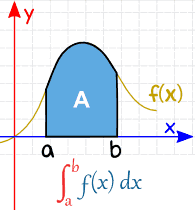The value of \(\int\limits_0^π \frac {e^{cos\ x} sinx}{(1+cos^2x)(e^{cos\ x}+e^{−cos\ x})}dx\) is equal to :
\(\frac {\pi^2}{4}\)
\(\frac {\pi^2}{2}\)
\(\frac {\pi}{4}\)
\(\frac {\pi}{2}\)
The Correct Option is C
Solution and Explanation
\(\int\limits_0^π \frac {e^{cos\ x} sinx}{(1+cos^2x)(e^{cos\ x}+e^{−cos\ x})}dx\)
Let \(cos\ x = t\)
\(sin\ x\ dx = dt\)
Then, \(\int\limits_{-1}^1 \frac {−e^tdt}{(1+t^2)(e^t+e^{−t})}\)
Let \(I =\int\limits_{-1}^1 \frac {−e^tdt}{(1+t^2)(e^t+e^{−t})}\) …..…(1)
\(I =\int\limits_{-1}^1 \frac {−e^tdt}{(1+t^2)(e^{−t}+e^t)}\) ….…(2)
On adding eq(1) and eq(2)
\(2I = \int\limits_{-1}^1 \frac {dt}{1+t^2}\)
\(2I = tan−t]_{−1}^1\)
\(2I = \frac {\pi}{4}−(−\frac {\pi}{4})\)
\(2I = \frac {π}{2}\)
\(I = \frac {π}{4}\)
So, the correct option is (C): \(\frac {π}{4}\)
Top Questions on Definite Integral
- Evaluate the definite integral: \( \int_{-2}^{2} |x^2 - x - 2| \, dx \)
- MHT CET - 2025
- Mathematics
- Definite Integral
- The value of the integral \[ \int_{-1}^{2} \log_e \left( x + \sqrt{x^2 + 1} \right) \, dx \] is:
- JEE Main - 2024
- Mathematics
- Definite Integral
The value \( 9 \int_{0}^{9} \left\lfloor \frac{10x}{x+1} \right\rfloor \, dx \), where \( \left\lfloor t \right\rfloor \) denotes the greatest integer less than or equal to \( t \), is ________.
- JEE Main - 2024
- Mathematics
- Definite Integral
- The value of \(\lim_{{n \to \infty}} \sum_{{k=1}}^{n} \frac{n^3}{{(n^2 + k^2)(n^2 + 3k^2)}}\) is
- JEE Main - 2024
- Mathematics
- Definite Integral
If the value of the integral
\[ \int_{-\frac{\pi}{2}}^{\frac{\pi}{2}} \left( \frac{x^2 \cos x}{1 + \pi^x} + \frac{1 + \sin^2 x}{1 + e^{\sin^x 2023}} \right) dx = \frac{\pi}{4} (\pi + a) - 2, \]
then the value of \(a\) is:
- JEE Main - 2024
- Mathematics
- Definite Integral
Questions Asked in JEE Main exam
Nature of compounds TeO₂ and TeH₂ is___________ and ______________respectively.
- JEE Main - 2025
- Inorganic chemistry
- Let \( A = [a_{ij}] \) be a matrix of order 3 \(\times\) 3, with \(a_{ij} = (\sqrt{2})^{i+j}\). If the sum of all the elements in the third row of \( A^2 \) is \( \alpha + \beta\sqrt{2} \), where \(\alpha, \beta \in \mathbb{Z}\), then \(\alpha + \beta\) is equal to:
- JEE Main - 2025
- Matrices and Determinants
Consider the following sequence of reactions :

Molar mass of the product formed (A) is ______ g mol\(^{-1}\).- JEE Main - 2025
- Organic Chemistry
The magnitude of heat exchanged by a system for the given cyclic process ABC (as shown in the figure) is (in SI units):

- JEE Main - 2025
- Electric charges and fields
- The value of \( (\sin 70^\circ)(\cot 10^\circ \cot 70^\circ - 1) \) is:
- JEE Main - 2025
- Trigonometric Identities
Concepts Used:
Definite Integral
Definite integral is an operation on functions which approximates the sum of the values (of the function) weighted by the length (or measure) of the intervals for which the function takes that value.
Definite integrals - Important Formulae Handbook
A real valued function being evaluated (integrated) over the closed interval [a, b] is written as :
\(\int_{a}^{b}f(x)dx\)
Definite integrals have a lot of applications. Its main application is that it is used to find out the area under the curve of a function, as shown below:
